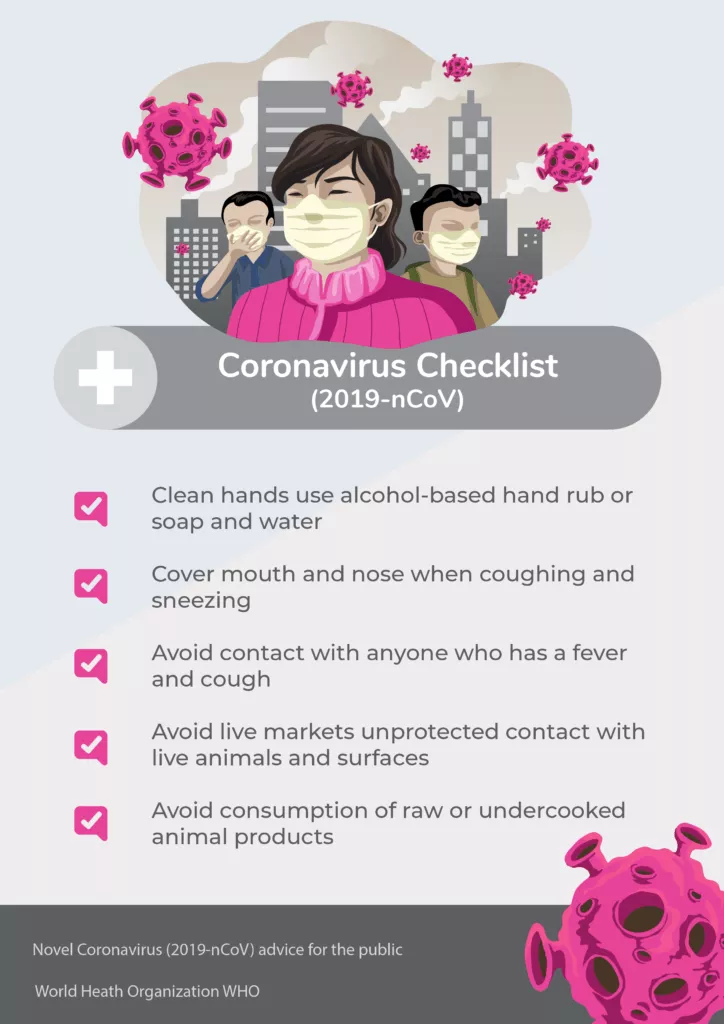
Coronavirus (2019-nCoV) COVID-19 has been all over the news and scared everyone the speed it is moving around the World.
This evening the World Heath Organization has announced public health emergency of international concern—only the sixth time such an emergency has been declared.
So what is Coronavirus (2019-nCoV)? A respiratory sickness not previously seen in humans.
If you develop a temperature, breathing difficulties after returning from a trip to Wuhan, China DO NOT leave your home before receiving advice from a doctor.
It is still unknown how exactly coronavirus spreads from person to person, but other similar viruses spread by cough droplets.
Using the advice given out by the World Health Organization WHO’s standard recommendations for the general public to reduce exposure and protect others from getting sick we have created a checklist.
Why is it called the 2019-nCoV?
This is a temporary name given to the virus by the World Health Organisation.
“2019” year discovered
“n” denote new or novel
“CoV” for coronavirus.
The final name of the disease will be provided by the International Classification of Diseases (ICD).
UPDATE: 11th Feb 2020 – WHO announce the formal name for the virus.
“We now have a name for the #2019nCoV disease: COVID-19.
#COVID19
Coronavirus (2019-nCoV) Symptoms
Symptoms usually include:
- Feeling tired
- Difficulty breathing
- High temperature
- Cough and or a sore throat
Reduce Exposure and Transmission

Download reduce exposure and transmission of Novel Coronavirus (2019-nCoV)
UPDATE: 26th Feb 2020 Self-quarantine so that you don’t infect others if you have been away in a high-risk area.
Non essential travel to Italy 10 small towns in Lombardy. (Codogno, Castiglione d’Adda, Casalpusterlengo, Fombio, Maleo, Somaglia, Bertonico, Terranova dei Passerini, Castelgerundo and San Fiorano) and one in Veneto (Vo’ Euganeo), which have been isolated by the Italian authorities due to an ongoing outbreak of coronavirus (COVID-19).
Additional Information 2019-nCoV
The World Health Organization Novel Coronavirus (2019-nCoV)
European Centre for Disease Prevention and Control Novel coronavirus
The Centers for Disease Control and Prevention (CDC) respiratory illness caused by a novel (new) coronavirus
Policy paper UK pandemic preparedness
WHO’s response to COVID-19 – Timeline of the pandemic from WHO
UK THRCC (Threats, Hazards, Resilience and Contingency Committee) was a sub-committee of the National Security Council (NSC), chaired by the Prime Minister was scrapped six months before the coronavirus. Its key role was protecting the country against a pandemic and ensuring we were ready to deal with the situation but the UK was heading towards a no-deal Brexit spending more time on EU exit strategy and the risk of a no-deal scenario time was not available on THRCC so Boris Johnson scrapped it.
The Early UK Response to the COVID-19 Crisis – Professor Paul Rogers January and February 2020
UK National Biological Security Strategy July 2018
UK Influenza Pandemic – Preparedness Strategy 2011
Exercise Cygnus: Tier One Command Post Exercise Pandemic Influenza 18 to 20 October 2016 – UK Government Preparedness and response for serious pandemic.
The report on Exercise Cygnus, the simulation of a fictitious influenza pandemic, warned that “the UK’s preparedness and response, in terms of its plans, policies, and capability, is currently not sufficient to cope with the extreme demands of a severe pandemic that will have a nationwide impact across all sectors.”
What is the difference between a epidemic and pandemic?
What is the difference between them as they seem rather similar?
EPIDEMIC is a disease affecting a large number of people within a community, or region.
PANDEMIC is an epidemic that’s spread further afield and over multiple countries or continents.
So really a pandemic is an epidemic that has spread over several countries or even continents, can affect a vast number of people.
Other Pandemics in Recent History
The World Health Organization was created in 1948
Spanish flu 1918-20: (H1N1)
Asian flu 1957-58: (H2N2)
7th cholera pandemic 1961- Now: World’s longest running pandemic
Caused by a bacterium called Vibrio cholera usually ingested contaminated food or water.
Hong Kong flu 1968-70: (H3N2)
AIDS 1981-Present Day: Aids pandemic
SIVcpz from chimpanzees in Cameroon, gave rise to HIV-1 group M crossed from monkeys to apes and from apes to humans.
BSE 1986: Bovine Spongiform Encephalopathy or Mad Cow Disease epidemic as stayed with one country the United Kingdom. Caused by the practice of feeding meat and bones to young calves.
SARS 2003: Severe Acute Respiratory Syndrome caused by a SARS-associated coronavirus.
Bird Flu 2005: (H5N1) avian influenza
MERS 2012 -Now: Middle East Respiratory Syndrome Coronavirus by a novel coronavirus (MERS‐CoV)
Swine flu 2009-10: (A/H1N1pdm09 or H1N1) Swine Flu (H1N1) Pandemic a respiratory disease in pigs that is caused by type A influenza virus.
Ebola 2014-16: Ebola virus disease (EVD) or Ebola hemorrhagic fever (EHF)
Zika 2015-16: Zika virus is a mosquito-borne flavivirus identified in humans in 1952.
Covid-19 2019-20: (sars-cov-2, 2019-nCoV) Like SARS and MERS,
Does the running of your business include several repetitive tasks? If there’s no guidance or procedure in place, it’s possible for some of the steps in the process to get forgotten. This is why checklists are important.
People get distracted, and when something gets forgotten, it’s much harder to recover than if they’d completed the task right in the first place.
Guidance every step of the way makes sure something is completed perfectly every time.
Read More: Why is a Checklist Important?
We all carry enormous knowledge and experience that we want to apply effectively, but we are all prone to make mistakes. There’s only so much we can store in our heads without forgetting something. How to maximise our use of knowledge?
The simple answer to this problem is to use checklists.
How many types of checklists are there? Two. What are the two types of checklists? Read-Do and Do-Confirm checklists are about how you use checklists.
Read More: Types of checklist: What are the two most powerful Checklist Types?
A checklist is a way to document each step needed to complete a task. A detailed set of instructions, a guide of how something is done.
Checklist software allows you to document every step of a process to be used over and over again.
Read More: Checklist Software